Why is my tree shedding its branches?
You’ve come home from a long day at work and are relaxing on your back deck when you notice it. Scads of tiny, thin branches — some with bright green leaves still attached - are scattered around your tree.
What could cause your tree to shed its branches? Is there something wrong with it? Worse yet, is it dying?
Probably not.

Trees are hardy. During severe drought, pine and hardwood trees conserve water by prematurely shedding needles and leaves. When leaves or needles don’t get enough sun, their branches often die, naturally pruning themselves from the tree.
The same happens when a loblolly pine is shaded by surrounding trees. Its lower branches simply die and drop off.
Homeowners are sometimes alarmed by this natural pruning because they think the tree is dying. But you shouldn’t necessarily worry if you come home and find pencil-sized branches at the base of your tree.
If there's been no bad weather, then branch abscission - also known as cladoptosis - is likely to blame. The phenomenon is similar to the process that occurs when trees shed their leaves each fall.
The process is relatively common in trees such as cottonwood, post oak, white oak, white ash, American beech, black cherry, black willow, bald cypress and longleaf pine. But it doesn’t occur in others like water oak, willow oak, black walnut, sugarberry, eastern red cedar and Virginia pine.
The picture above to the right shows the typical swelling and smooth break that often is found when branches fall off as a result of abscission. In the case of hardwood trees, twig girdling beetles also may prune off the ends of small branches. More information is available on twig girdling beetles.